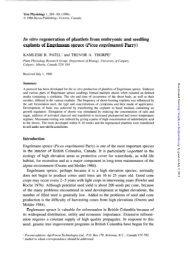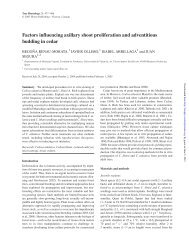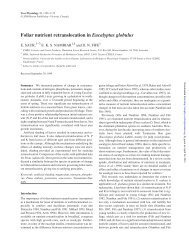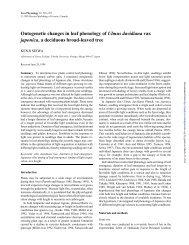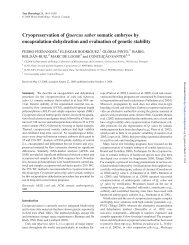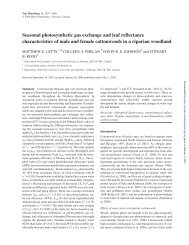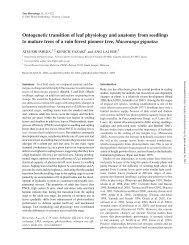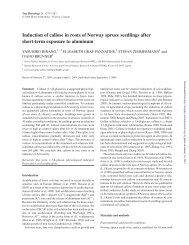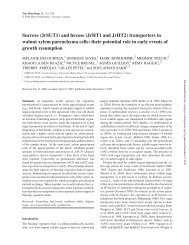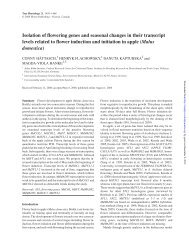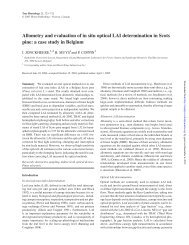Hara: the effect of xylem structures - Tree Physiology
Hara: the effect of xylem structures - Tree Physiology
Hara: the effect of xylem structures - Tree Physiology
You also want an ePaper? Increase the reach of your titles
YUMPU automatically turns print PDFs into web optimized ePapers that Google loves.
tional vessels in each <strong>xylem</strong> <strong>of</strong> <strong>the</strong> cross section, as shown<br />
below (Tyree and Ewers 1991).<br />
<strong>the</strong>oretical Ks ¼ ðπρ=128ηAwÞ∑ n<br />
i−1<br />
d 4 i<br />
ð4Þ<br />
In that equation, ρ represents <strong>the</strong> density <strong>of</strong> <strong>the</strong> solution<br />
(kg m −3 ), η is <strong>the</strong> dynamic viscosity <strong>of</strong> <strong>the</strong> solution<br />
(MPa s), A w signifies <strong>the</strong> <strong>xylem</strong> cross-sectional area (m 2 ),<br />
d denotes <strong>the</strong> diameter (m) <strong>of</strong> <strong>the</strong> ith vessel and n stands<br />
for <strong>the</strong> number <strong>of</strong> vessels in <strong>the</strong> section observed for <strong>xylem</strong><br />
anatomy. Calculation <strong>of</strong> <strong>the</strong>oretical K s before dehydration<br />
was conducted on three cross sections analyzed for <strong>xylem</strong><br />
anatomy to evaluate <strong>the</strong> contribution <strong>of</strong> current <strong>xylem</strong> hydraulic<br />
conductivity to <strong>the</strong> hydraulic conductivity <strong>of</strong> <strong>the</strong><br />
whole <strong>xylem</strong> (see Table 1). Fur<strong>the</strong>rmore, <strong>the</strong>oretical K s obtained<br />
from three cross sections for each water status—<br />
after dehydration and two rehydration periods in addition<br />
to ‘before dehydration’—are shown for diffuse-porous B.<br />
platyphylla to examine <strong>the</strong> <strong>effect</strong>s <strong>of</strong> <strong>xylem</strong> age on <strong>the</strong><br />
extent <strong>of</strong> vessel refilling and consequently on <strong>the</strong> recovery<br />
<strong>of</strong> measured K s (see Figure 7).<br />
Statistical analyses<br />
One-way ANOVA was used to test <strong>the</strong> <strong>effect</strong> <strong>of</strong> different water<br />
status on hydraulic conductivity or <strong>xylem</strong> water potential.<br />
Dunnett’s test was applied for multiple comparisons among<br />
water status. S<strong>of</strong>tware (Statistica; StatS<strong>of</strong>t Inc. USA) was<br />
used for statistical analyses.<br />
LOSS OF XYLEM CONDUCTIVITY AND ITS RECOVERY 5<br />
Figure 4. Vessel diameter distribution in 5 μm classes in Q. serrata (A, B) and B. platyphylla (C, D). A and C show data for <strong>the</strong> current <strong>xylem</strong>,<br />
B and D show 1-year-old <strong>xylem</strong>. Class means ± SD (n = 15). Data in each graph represent mean ± SD <strong>of</strong> <strong>the</strong> vessel number (vessel mm −2 ) and<br />
diameter (µm).<br />
Results<br />
Dehydration vulnerability curves<br />
Although <strong>the</strong> data presented herein varied widely throughout<br />
<strong>xylem</strong> water potential, about 40% loss <strong>of</strong> hydraulic conductivity<br />
was recorded in <strong>the</strong> high <strong>xylem</strong> water potential in Q.<br />
serrata (Figure 1A). The percentage loss <strong>of</strong> hydraulic conductivity<br />
increased slightly with decreasing Ψ<strong>xylem</strong> values.<br />
By contrast, B. platyphylla showed no loss <strong>of</strong> hydraulic<br />
conductivity <strong>of</strong> Ψ <strong>xylem</strong> values between 0 and −1.5 MPa<br />
(Figure 1B). At lower Ψ <strong>xylem</strong> values, <strong>the</strong> percentage loss <strong>of</strong><br />
hydraulic conductivity <strong>the</strong>n increased sharply. At Ψ<strong>xylem</strong> <strong>of</strong><br />
less than −2.0 MPa, <strong>the</strong> loss <strong>of</strong> hydraulic conductivity was<br />
raised more than 80%.<br />
Recovery <strong>of</strong> hydraulic conductivity and Ψ <strong>xylem</strong><br />
Specific conductivity (K s)inQ. serrata was decreased by dehydration<br />
from 12.0 kg m −1 MPa −1 s −1 under well-watered<br />
conditions to 7.0 kg m −1 MPa −1 s −1 (Figure 2A) after rewatering,<br />
but no significant difference was found between <strong>the</strong>m.<br />
In addition, <strong>the</strong> mean values <strong>of</strong> K s did not recover significantly<br />
in ei<strong>the</strong>r 1- or 12-h rehydration periods. In contrast, B. platyphylla<br />
exhibited a significant loss <strong>of</strong> K s from 2.9 to 1.4 kg<br />
m −1 MPa −1 s −1 by dehydration but recovered rapidly to <strong>the</strong><br />
value equal to that under well-watered conditions (1 h)<br />
(Figure 2B). Comparison <strong>of</strong> K s values among species shows<br />
that Q. serrata displayed higher hydraulic efficiency than B.<br />
platyphylla through water status.<br />
TREE PHYSIOLOGY ONLINE at http://www.treephys.oxfordjournals.org<br />
Downloaded from<br />
http://treephys.oxfordjournals.org/ by guest on December 10, 2012



